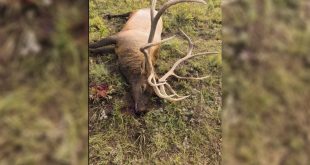Young BigHorn Rams Removed Near Lander
By Jaden Bales and Wyoming Wildlife Federation
Lander wildlife officials recently confirmed the removal of three young ram bighorn sheep in Sinks Canyon on June 12th.
These sheep most likely wandered into Sinks Canyon, a place without bighorn sheep since thefamous Bam Bam the ram was removed a decade ago, from the North Fork Canyonapproximately 10 miles north. These three rams were around 2 years old and on their way toSinks Canyon and likely passed through domestic sheep herds between there and the North Fork of the Popo Agie River.
Removing these Bighorn sheep is an accepted and well-used practice within wildlife agencies. While it sounds extreme, this action was imperative to prevent the sheep from returning to their home herd or other herds carrying a pneumonia pathogen that may compromise the rest of the wild sheep and cause population-level impacts due to disease. This is part of the tricky balancing act of wildlife management.
Removing these young rams should be seen as a positive step in wild sheep conservation and management across the state. How Wyoming balances wildlife and agricultural needs is imperative to long-term success in all wildlife conservation.
This standard removal procedure is not novel to bighorn sheep management in Fremont County, nor within Wyoming itself. Wandering wild sheep, usually young rams looking for new habitats, are removed to prevent the risk of the transfer of pathogens to healthy bighorn sheep herds.
Scenarios like this are why WGFD implemented type-2 licenses for less-than ¾ curl rams this year in certain areas, allowing for additional hunter opportunities on animals that may have already been removed for wandering by WGFD officials.
Additionally, WGFD has made commitments and is responsible for ensuring that they can maintain wild sheep in the designated management areas of the Wyoming Bighorn/Domestic Sheep Interaction Plan. While Sinks Canyon has good wild sheep habitat, it is not within a core herd area of the Wyoming plan nor is it likely to ever be. The proximity of domestic sheep to the canyon itself creates a high risk of contact and a risky disease landscape for both sides of the equation. For the health of the current bighorn herds to the north of the Canyon, WWF supports the WGFD’s continued removal of bighorns that wander into Sinks.
We commend the Wyoming Game and Fish Department for doing its part to remain accountable to the Wyoming Plan and also to remove sheep that may cause disease risks to healthy herds.
We hope the other stakeholders who may be hesitant to support bighorn sheep reintroduction can build trust in the approach of the wildlife agency to keep wild sheep herds healthy without sacrificing domestic livestock production, working landscapes, and most importantly the livelihoods of many folks in Wyoming.
Cover photo of young Ferris Mountain bighorn ram by Samuel Pyke
 Eastmans' Official Blog | Mule Deer, Antelope, Elk Hunting and Bowhunting Magazine | Eastmans' Hunting Journals
Eastmans' Official Blog | Mule Deer, Antelope, Elk Hunting and Bowhunting Magazine | Eastmans' Hunting Journals




